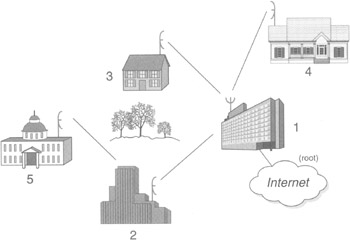Line of Sight, Near Line of Sight, and Non Line of Sight
|
|
Another objection raised to 802.11 networks is the perception that a subscriber must be located on a direct line of sight from the transmitter. Some detractors fear that this would necessitate an unsightly forest of roof antennas in residential settings not unlike the TV antennas of the 1950s and 1960s. Given the threat to the aesthetics of some residential neighborhoods, some zoning commissions would attempt to outlaw antennas for wireless networks. Others fret that many households would not be able to benefit from wireless broadband as their homes would not be located on a direct line of sight from the service provider's transmitter. Although these are valid considerations, the following paragraphs address the issue of engineering an area to deliver service to the maximum number of subscribers in reach of a service provider's transmitters.
Fresnel Zone and Line-of-Sight Considerations
Line of sight in microwave includes an area around the path called the Fresnel zone. The Fresnel zone is an elliptical area immediately surrounding the visual path. It varies depending on the length of the signal path and the frequency of the signal. The Fresnel zone can be calculated and must be taken into account when designing a wireless link. Any object within the Fresnel zone attenuates the transmission path between two points. The maximum radius of the Fresnel zone can be calculated by the following formula:
| (5-3) |
where d is the distance in miles and f is the frequency in GHz.
For a 5-mile link at 2.4 GHz, the radius is 31.25 feet.
Line of sight means a direct, unobstructed path exists from the transmitter to the receiver. This usually means in any wireless network that the transmission will suffer less degradation than it would if an object(s) was obstructing that path. Line of sight is the best possible configuration for transmission on 802.11 networks.
Non line of sight means the radio link is blocked. However, with proper engineering, it is possible to receive 802.11 services without having a direct line of sight to the service provider's transmitter. This term usually applies where the service provider has deployed its transceivers in a cell network where a backbone services individual cells. If a subscriber is in a location that is non line of sight, he or she will not be served by the WISP. To reach that prospective customer, the service provider would have to deploy a new, costly base station.
One alternative to a new base station would be any-point-to-multipoint technology or an ad hoc peer-to-peer network. In the case of an any-point-to-multipoint network topology, any node already in the network can be used as a relay point to reach the central site (see Figure 5-4). If location 5 is within the line of sight of location 2, for example, node 2 will start functioning as a repeater by simply installing a wide focus antenna connected to its port B. At the new subscriber site (location 5), a transceiver is installed with a directional antenna pointing at location 2.[8]

Figure 5-4: Using any-point-to-multipoint technology to reach a non-line-of-sight subscriber
Ad hoc peer-to-peer technology, also known as mesh networks, can also provide a cost-effective means of providing service to non-line-of-sight locations. Single long radio links are replaced with several shorter ones that are less susceptible to noise and multipath. In an ad hoc peer-to-peer network, something as simple as a subscriber device (a handheld personal digital assistant [PDA], cell phone laptop, and so on) can be used as a repeater to reach an AP or base station. The downside is that current client adapters must use new client software to control the routing function of the subscriber device and change it from infrastructure and ad hoc as needed. The cost of APs, base station technology, and wireless routers is becoming less expensive as time goes by. Therefore, a service provider's ability to reach subscribers increases with time. The same goes for potential subscribers if they want to provide the equipment to receive wireless broadband. Not having line of sight to a base station or AP should not prevent them from receiving the benefits of wireless broadband.
[8]Nuno Bandeira and Larz Poulsen, "Broadband Wireless Network Overcomes Line-of-Sight (LOS) Constraints and Lowers Deployment Cost," a white paper from Wi-LAN, www.wi-lan.com.
|
|
EAN: 2147483647
Pages: 96